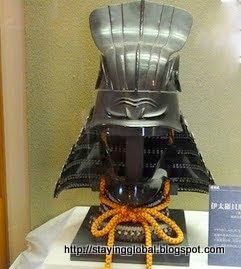This weekend, we visited yet another castle ! This time it was the Kiyosu castle .
Kiyosu castle was built in early 15th century by the local daimyo(feudal lord), Shiba Yoshishige.It was a simple castle surrounded by a single moat which later on became the residence of Oda Nobunaga, who was one of the important feudal lords in the history of Japan . He succeeded in unifying Owari (current day Nagoya and surrounding areas) but died before he could fulfill his dream of unifying Japan. The castle was remodeled and expanded by his son Oda Nobuo. During this reconstruction, a triple moat was also constructed. Later the castle came to be occupied by Oda Nobunaga's successor, Toyotomi Hideyoshi who went on to become the first person to unify the whole of Japan. When Tokugawa Ieyasu, the founder of the Shogunate came to rule the nation, he ordered the castle to be pulled down and the materials from this castle were used to construct the Nagoya Castle. No remains of the original Kiyosu castle now remain in the current reconstruction. However the golden 'kinshachi' which adorned the roofs of the original castle are now stored at the Oda clan's Sofukuji temple in neighbouring Gifu prefecture. The painted sliding doors from the original castle are at the Sokenji temple in Nagoya while the castle's gate is preserved at the Ryofukuji temple in Owariasahi.
The red Otebashi bridge across the Gojo river leads to the Castle's main gate, the Otemon.
The current castle's Donjon is a four storied ferroconcrete reconstruction which dates to 1989. The castle is built in style similar to the Inuyama castle because no plans or information about the original Kiyosu castle have survived.
The castle is a flatland castle.
A small Japanese garden and a rock gardern are also located on the Castle ground.
Wooden stairs lead up to each floor. Swords, armors, roof tiles and other artifacts are on display on the first 3 floors of the castle.
A lookout balcony on the fourth floor offers a view of the city.
A model of the golden shachihoko is also displayed on this floor.
A taiko drum and a statue of Oda Nobunaga are also displayed on the top floor.
Address: Aichi Prefecture, Kiyosu-shi, Asahi 1-1, Kiyosu-Jo
Phone: 052-409-7330
Entrance fees: Adults: 300 yen
Closed: Mondays and December 29-31
Nearest access : 15 minutes walk from JR Kiyosu station or Meitetsu Shin Kiyosu station.
Kiyosu castle was built in early 15th century by the local daimyo(feudal lord), Shiba Yoshishige.It was a simple castle surrounded by a single moat which later on became the residence of Oda Nobunaga, who was one of the important feudal lords in the history of Japan . He succeeded in unifying Owari (current day Nagoya and surrounding areas) but died before he could fulfill his dream of unifying Japan. The castle was remodeled and expanded by his son Oda Nobuo. During this reconstruction, a triple moat was also constructed. Later the castle came to be occupied by Oda Nobunaga's successor, Toyotomi Hideyoshi who went on to become the first person to unify the whole of Japan. When Tokugawa Ieyasu, the founder of the Shogunate came to rule the nation, he ordered the castle to be pulled down and the materials from this castle were used to construct the Nagoya Castle. No remains of the original Kiyosu castle now remain in the current reconstruction. However the golden 'kinshachi' which adorned the roofs of the original castle are now stored at the Oda clan's Sofukuji temple in neighbouring Gifu prefecture. The painted sliding doors from the original castle are at the Sokenji temple in Nagoya while the castle's gate is preserved at the Ryofukuji temple in Owariasahi.
The red Otebashi bridge across the Gojo river leads to the Castle's main gate, the Otemon.
The current castle's Donjon is a four storied ferroconcrete reconstruction which dates to 1989. The castle is built in style similar to the Inuyama castle because no plans or information about the original Kiyosu castle have survived.
The castle is a flatland castle.
A small Japanese garden and a rock gardern are also located on the Castle ground.
Wooden stairs lead up to each floor. Swords, armors, roof tiles and other artifacts are on display on the first 3 floors of the castle.
A lookout balcony on the fourth floor offers a view of the city.
A model of the golden shachihoko is also displayed on this floor.
A taiko drum and a statue of Oda Nobunaga are also displayed on the top floor.
Address: Aichi Prefecture, Kiyosu-shi, Asahi 1-1, Kiyosu-Jo
Phone: 052-409-7330
Entrance fees: Adults: 300 yen
Closed: Mondays and December 29-31
Nearest access : 15 minutes walk from JR Kiyosu station or Meitetsu Shin Kiyosu station.






No comments:
Post a Comment